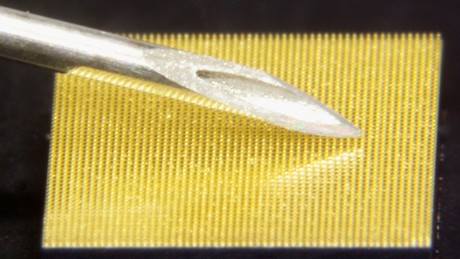Needle-free vaccine delivery wins Young Florey Medal

The winner of the 2016 CSL Young Florey Medal is Queensland rocket scientist Professor Mark Kendall. He has been awarded the biennial prize for inventing a vaccine delivery system that is painless, efficient and eliminates the need for refrigeration.
Dubbed ‘Nanopatch’, the system consists of a 1 cm2 silicon patch with 20,000 microscopic needles that painlessly penetrate the outer layer of skin, delivering a tiny but efficacious dose of dry vaccine to the immune cells that reside just under the outer layer of skin. For 160 years, vaccines have been delivered via needle and syringe, but Professor Kendall’s invention has the potential to transform the way vaccines are delivered in the areas where they are most needed.
Traditional wet vaccines require refrigeration, which can be problematic in remote communities. Another barrier to vaccination is needle phobia, which can affect up to 20% of the population. The research for Nanopatch has been funded by the Bill & Melinda Gates Foundation, Merck and the World Health Organization (WHO). The first field application of Nanopatch is planned for next year with a polio vaccine trial in Cuba.
The road that led to Nanopatch started when Professor Kendall was approached by a team from the University of Oxford to help develop a handheld rocket for vaccine delivery. The result was PowderJect, a device that shoots vaccine particles into the skin at twice the speed of sound. Purchased by Pfizer for $500 million, PowderJect has yet to make it to market.
Professor Kendall was then approached by the Bill & Melinda Gates Foundation, which was looking for a more efficient way to deliver vaccines to remote populations. Realising that the technology behind PowderJect was too complex and expensive for these requirements, Professor Kendall went back to the drawing board and developed Nanopatch under the umbrella of University of Queensland spin-out company Vaxxas, which has begun human trials of the Nanopatch with additional assistance from Merck.

Professor Kendall said: “We’ve got a chance to help stimulate fresh lines of innovation and biotechnology here. There’s 14 million deaths per year due to infectious disease, and so my vision for the Nanopatch is to get more effective vaccines to more people and help save lives.”
Professor Kendall leads the Queensland node of the ARC Centre of Excellence for Convergent Bio-Nano Science & Technology. He is Professor of Biomedical Engineering at the Australian Institute for Bioengineering and Nanotechnology at The University of Queensland and founder, chief technology officer and a director of Vaxxas.
Personality influences the expression of our genes
An international research team has used artificial intelligence to show that our personalities...
Pig hearts kept alive outside the body for 24 hours
A major hurdle for human heart transplantation is the limited storage time of the donor heart...
Breakthrough antibiotic for mycobacterial infections
The antibiotic candidate, named COE-PNH2, has been optimised to target Mycobacterium...







